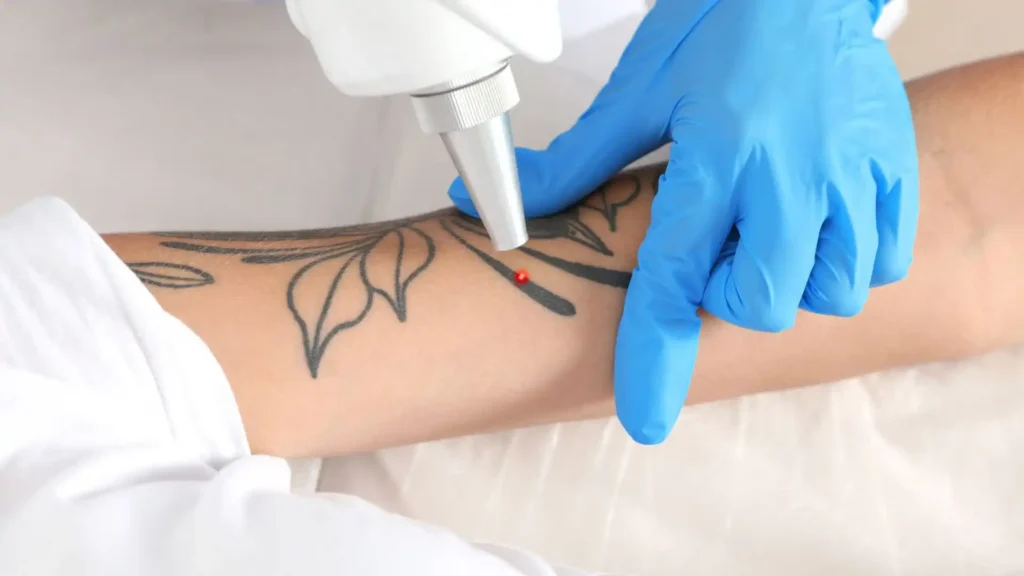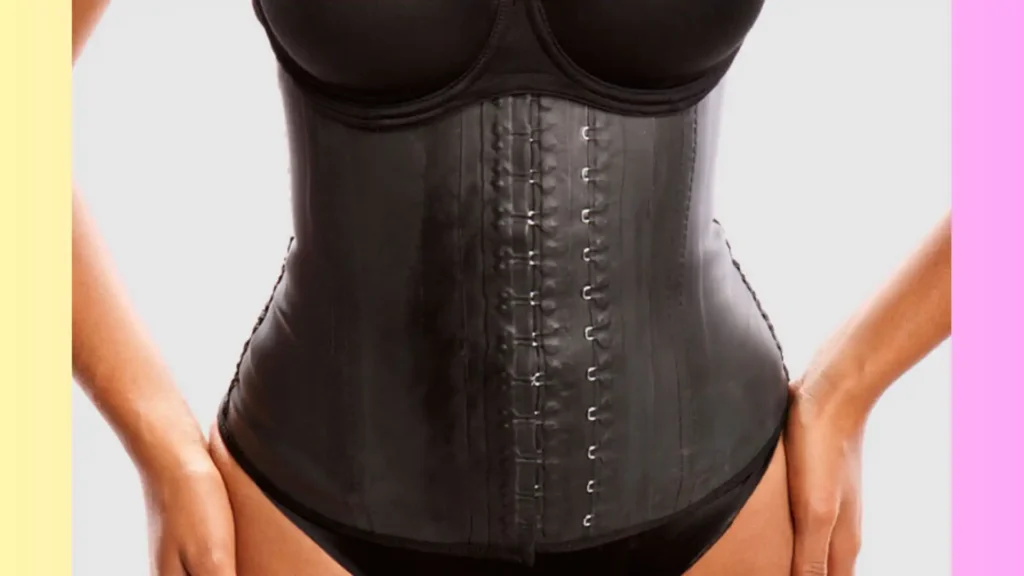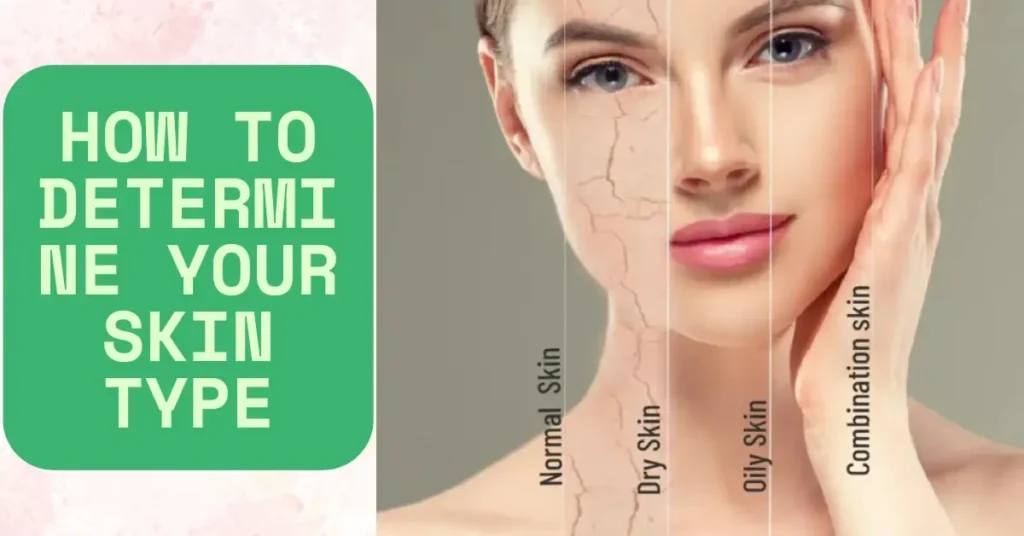Starting a tattoo removal journey can change your life. It lets you take back control of your body and image. Today’s advanced laser tech can make your tattoos fade or disappear completely.
This process is safe, effective, and made just for you. With the help of experts, you can get the tattoo-free look you want. This will boost your confidence and open the door to a new beginning.
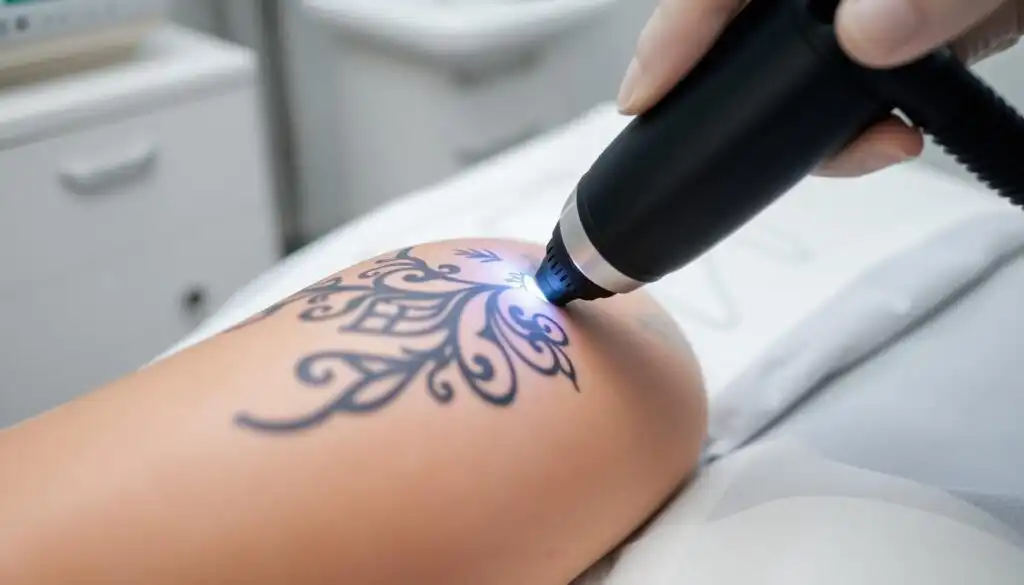
For tattoo removal to work, it’s key to know your ink and skin. Skilled doctors use top-notch lasers to target and remove the ink. Your body then gets rid of the ink naturally.
This process might take a few sessions, but the outcome is worth it. Many people have found that this method truly works.
Understanding Tattoo Removal: A Fresh Start
Tattoos mean a lot to us, but our lives change. Tattoo regret can happen for many reasons, like job changes or ending relationships. If you want a new start, tattoo removal can help. It lets you take back your skin and feel confident again.
Common Reasons for Tattoo Removal
People remove tattoos for several reasons:
- Career changes or professional considerations
- Ending of relationships or personal transformations
- Changing personal style or outgrowing a tattoo design
- Tattoo regret or a desire to remove unwanted tattoos
Types of Tattoos That Can Be Removed
Laser technology has improved a lot. Now, you can remove many tattoo types, including:
- Colorful sleeves or full-body designs
- Small, simple tattoos like names or symbols
- Tattoos in various colors, such as black, red, blue, and green
The Psychology Behind Tattoo Removal Decisions
Deciding to remove a tattoo is a big step. It’s a chance to leave the past behind and start anew. The tattoo removal motivation and tattoo removal psychology involve deep feelings. These include wanting to express yourself, grow, and change.
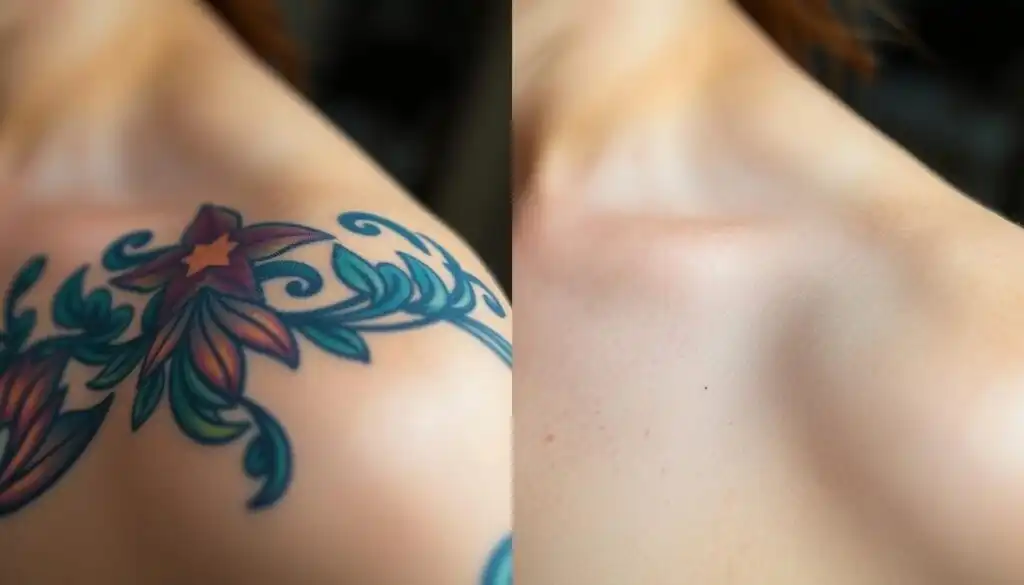
“Tattoo removal is not just a physical process, but an emotional one as well. It’s about reclaiming your identity and feeling empowered to write the next chapter of your life.” – Dr. Marc Wetherington, Plastic Surgeon
How Laser Tattoo Removal Technology Works
The laser tattoo removal process is safe and effective. It uses special lasers to target and break down tattoo ink in the skin. The heat from these lasers shatters the pigment into smaller pieces. Then, the body’s immune system naturally removes these pieces.
Q-switched lasers are a common tool in tattoo removal. They send out brief pulses of energy, lasting just a few nanoseconds. This energy effectively targets and breaks down many tattoo ink colors, including blues and greens. Picosecond lasers are even more advanced, delivering even shorter pulses of energy.
The number of sessions needed for laser tattoo removal varies. It depends on the tattoo’s size, color, and depth. Sessions are usually 6-8 weeks apart, lasting 15-30 minutes each. After each session, the body’s healing process gradually removes the ink.
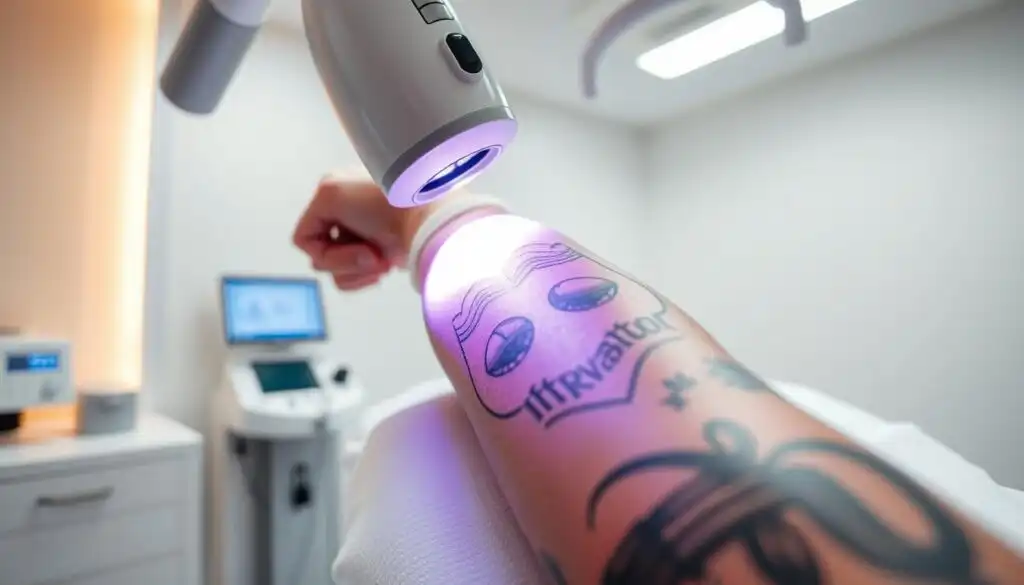
Thanks to tattoo removal technology, most tattoos can be removed successfully. This is often done with little to no scarring or discoloration. People with unwanted tattoos now have a reliable and effective solution.
The Science Behind Professional Tattoo Removal
Removing a tattoo is more than just a cosmetic procedure. It involves advanced laser technology and the body’s natural healing process. The discovery of selective photothermolysis has changed tattoo removal. Now, it’s more effective and doesn’t leave scars.
Advanced Laser Systems and Their Effectiveness
Specialized lasers, like Q-switched neodymium:yttrium-aluminum-garnet, alexandrite, and ruby lasers, are key to tattoo removal. These lasers work in the nanosecond domain. They target tattoo ink with precision, reducing the risk of skin damage.
The laser’s wavelength and intensity can be adjusted. This ensures the best tattoo ink breakdown and removal, based on the tattoo’s color and depth.
Breaking Down the Ink Removal Process
The laser breaks down tattoo pigment into smaller particles. These particles can be absorbed and eliminated by the body. This method is much better than old techniques like abrasives or thermal methods. Those often left scars and didn’t remove the tattoo fully.
Role of Your Body’s Natural Healing
While lasers do most of the work, your body’s natural healing process is crucial for laser tattooremoval effectiveness. As the ink particles are flushed out, your skin rejuvenates. This leaves your skin clearer and more uniform.
Proper aftercare and sun protection are key during this healing phase. They help ensure the best results.

“Approximately 20 years ago, modern tattoo removal began as a scientific endeavor, with few significant advances in the recent past.”
Tattoo Removal Before and After: Real Results
Seeing a tattoo you once loved fade away can be freeing. Thanks to new laser technology, getting rid of tattoos is easier than before. Tattoo removal results, before and after photos, and tattoo removal success stories show how far this field has come.
Over 1.3 million tattoos have been removed by top experts. Most people see their tattoos fade by 90-95% after treatment. It usually takes three to five sessions to start seeing changes. On average, it takes 10-12 sessions to fully remove a tattoo, with breaks of six to eight weeks between each.
“The results of my tattoo removal treatment have been life-changing. I’m thrilled with the fading of my unwanted tattoo, and it’s given me a fresh start. Seeing the before and after photos is truly remarkable.”
Removery, a leading tattoo removal service, has treated over 250,000 tattoos. They found most can be removed in 10-12 sessions. These tattoo removal success stories show how professional removal can change lives, turning regretful tattoos into clean slates.
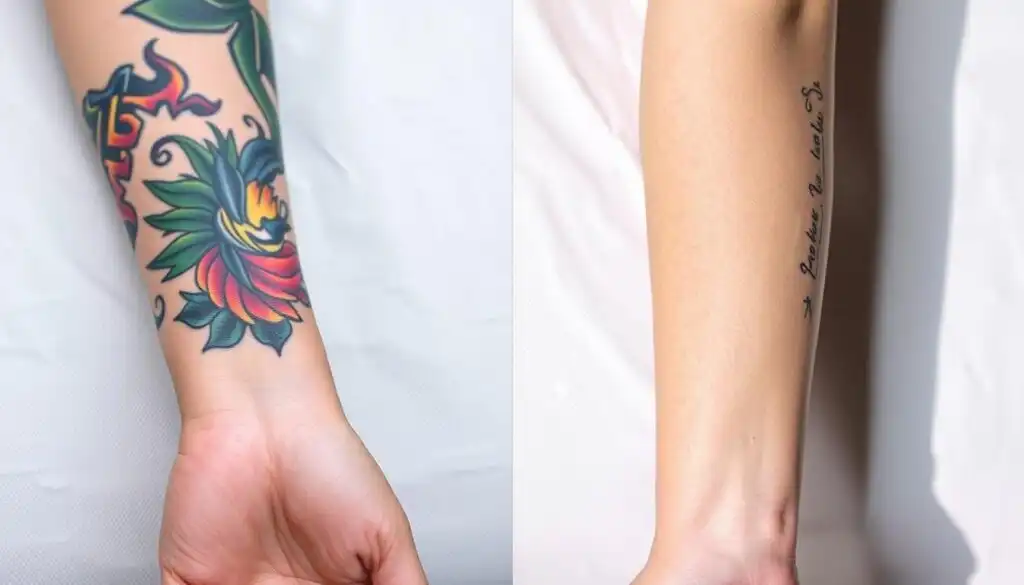
To get the best tattoo removal results, work with a licensed dermatologist or tattoo removal expert. They’ll create a plan just for you, considering your tattoo, skin, and needs. This ensures a safe and effective way to change your life.
What to Expect During Your Removal Journey
Starting your tattoo removal journey begins with a first meeting. In this session, your provider will look at your tattoo and talk about the best ways to remove it. This meeting is key because it helps you understand how long it will take and what to expect.
Initial Consultation Process
The tattoo removal consultation is a detailed look at your tattoo. Your provider will check its size, depth, and ink type. They will also think about your skin and health history to find the best laser treatment. This is your chance to ask questions and learn about the tattoo removal process.
Treatment Timeline and Sessions
The tattoo removal timeline depends on your tattoo’s complexity. Most people need several sessions, 6-8 weeks apart, each lasting 15-30 minutes. Right after the first treatment, you’ll see the tattoo start to fade, especially around the edges.
The number of sessions can vary from 3 to 12. This depends on the tattoo’s size, ink, and how your body reacts. Colors like green and blue might need more treatments to remove completely.
Recovery Between Treatments
The tattoo removal recovery is usually quick, with some redness, swelling, or itching. Taking good care of the treated area is key for the best results. This means keeping it clean and dry, using ointments for inflammation, and following your provider’s advice on blisters.
As you go through the tattoo removal journey, you’ll feel more at ease and informed. Staying positive and following aftercare advice can help you get the best results.
Managing Pain and Discomfort During Treatment
Getting a laser tattoo removal can feel a bit like getting the tattoo again. But, the pain is short, lasting just a few seconds. Most people find it bearable and not as bad as they thought it would be.
Clinics use different methods to make you feel more comfortable. They might use coolers to chill your skin down to -30°C. They also apply numbing creams like Emla 5% for 45 minutes before starting. Taking ibuprofen or acetaminophen beforehand can also help with the pain.
For bigger tattoos, they might use lidocaine shots to help with pain. Stress balls can also help you relax and feel less anxious. Some people might feel less pain during their period, which could affect how much discomfort they feel during the removal.
“Laser tattoo removal is generally described as bearable but painful compared to getting a tattoo. However, the discomfort is brief and can be effectively managed through a variety of techniques.”
Even though there might be some pain, your provider will make sure you’re comfortable. They will do their best to reduce any discomfort you might feel during your treatment.
Recovery and Aftercare Guidelines
After getting a tattoo removed, it’s key to follow the right tattoo removal aftercare for the best results. Simple steps can help your skin heal well and look great. This way, you’ll get the results you want.
Post-Treatment Care Instructions
Right after your treatment, keep the area clean. Use mild soap and water, but don’t scrub. Apply a thin layer of ointment to soothe the skin and prevent irritation. Also, avoid direct sun to speed up healing.
Signs of Normal Healing
- Mild redness and swelling in the treated area
- Formation of a scab or light crust as the skin heals
- Itchiness or a tingling sensation during the initial stages
These signs of normal healing show your body is responding well to the treatment. Be patient and don’t pick or scratch. This can cause problems and slow healing.
When to Contact Your Provider
Most of the time, healing goes smoothly. But, watch out for these signs and call your provider if you see them:
- Excessive pain or discomfort that does not subside
- Significant swelling, redness, or signs of infection (such as pus or fever)
- Bleeding that does not stop or appears to be worsening
Quick action can keep your post-treatment care on track. This way, any problems get fixed fast.
Cost Considerations and Treatment Plans
The cost of removing a tattoo can change a lot. It depends on the tattoo’s size, color, and where it is on your body. On average, removing small tattoos can cost between $50 to $100. But, removing a full sleeve can cost $800 to $1,500 or more.
How many sessions you need also affects the cost. Smaller tattoos might need only 2 to 3 sessions. But, bigger tattoos could need 6 to 10 sessions to be fully removed.
When you’re planning to remove your tattoo, think about the number of sessions and the ink type. Darker inks like black and blue are easier and cheaper to remove. But, colors like green and yellow are harder and more expensive.
Also, the ink’s depth and your skin type can change the cost. Many clinics offer special plans and package deals for multiple sessions. This can help you save money on your tattoo removal.
It’s a good idea to ask if your provider has any discounts. They might offer savings if you remove multiple tattoos at once or pay for all sessions upfront.
FAQ
What is the tattoo removal process?
Tattoo removal uses advanced laser technology. It breaks down tattoo ink, letting the body remove it naturally. The process is safe and effective, with little risk of scarring if done by experts.
Why do people seek tattoo removal?
People remove tattoos for many reasons. This includes career changes, ending relationships, or growing out of the design. Most tattoos, like colorful sleeves and names, can be removed.
How does laser tattoo removal work?
Laser tattoo removal targets and breaks down tattoo ink. The laser’s heat turns the pigment into smaller pieces. Then, the body’s immune system removes these pieces naturally.
What are the benefits of professional tattoo removal?
Professional tattoo removal uses advanced lasers. These lasers penetrate deep into the skin to effectively break down tattoo ink. It’s safer and more effective than surgery or creams, with less risk of scarring or skin damage.
What can I expect from the tattoo removal journey?
The journey starts with a consultation, followed by sessions every 6-8 weeks. Each session lasts 15-30 minutes. Afterward, there’s minimal downtime and some temporary side effects.
How much does tattoo removal cost?
Tattoo removal costs vary. It depends on the tattoo’s size, color, and location. Most clinics offer personalized plans and package pricing for multiple sessions.
Discover more trends:
- An Artist Does Breathtaking Tattoos That Look Like They’re Straight Out of a Fairytale
- How to remove temporary tattoos without damaging your skin with makeup remover?
- 10 Ear Tattoos That Look More Eye-Catching Than a Pair of Fancy Earrings
- Everything You Need to Know About Eyebrow Tattoos Before Getting the Treatment
- Scar Stretch Marks Removal – All You Need To Know!
- Follow us on Facebook
- Follow us on Pinterest

